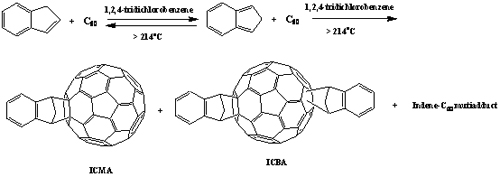ICCAS made significant progress in the studies on new C60 derivatives as acceptor in high performance polymer solar cells
Under the support of NSFC key project and NSFC-NSF joint project, the researchers from CAS Key Laboratory of Organic Solids, ICCAS, China, collaborated with Solarmer Energy Inc., USA, made significant progress in the studies on new C60 derivatives for the application as acceptor in high performance polymer solar cells (PSCs) recently.
Polymer solar cells (PSCs) are commonly composed of a blend film of a conjugated polymer donor and a soluble C60 derivative acceptor sandwiched between an ITO anode and a low workfunction metal cathode. Poly(3-hexylthiophene) (P3HT) and [6,6]-phenyl-C-61-butyric acid methyl ester (PCBM) are the widely used donor and acceptor materials respectively. The power conversion efficiency (PCE) of the PSCs based on P3HT/PCBM reached ca. 3.5~4.0%, and their photovoltaic performance is insensitive to the thickness of the active layers of the devices. Therefore, the devices based P3HT/PCBM is promising for future febricaiton in large area PSCs. However, too low LUMO energy level of PCBM limits the open circuit voltage (Voc) of the P3HT-based PSCs to ca. 0. 6 V. Here we synthesized a new soluble C60 derivative, Indene-C60 bisadduct (ICBA) (see Figure 1), with 0.17 eV higher LUMO energy level than PCBM. The PSC based on P3HT with ICBA as acceptor shows a higher Voc of 0.84 V and higher power conversion efficiency (PCE) of 5.44% under the illumination of AM1.5, 100 mW/cm2, while the PSC based on P3HT:PCBM displays Voc of 0.58 V and PCE of 3.88% under the same experimental conditions (I-V curves are shown in Figure 2). The results indicate that ICBA is an alternative high performance acceptor and could be widely used in high performance PSCs. The results were published in JACS recently. (J. Am. Chem. Soc., 2010, 132, 1377-1382.)
In addition, they also synthesized a series of PCBM-like C60 derivatives with different alkyl chain length on its substituent, F1~F5 (see Figure 3), where F2 is PCBM itself. The PSCs were fabricated with the PCBM-like molecules as acceptor and P3HT as donor. They found that the alkyl length on their substituents influenced the photovoltaic performance significantly. The PCEs of the devices are 3.66%(F1), 3.52%(F2), 2.28%(F3), 3.59%(F4) and 2.83%(F5)) respectively. The photovoltaic performance of F1 with one carbon shorter alkyl chain and F4 with two carbons longer alkyl chain is similar or slightly higher than that of PCBM with PCEs higher than 3.5%,while that of F3 with one carbon longer alkyl chain and F5 with three carbons longer alkyl chain is poorer than that of PCBM obviously. They explained the phenomenon from the effect of the alkyl chain length on the electron mobility and the absorbance of the blend films of P3HT/F1~F5. The results were accepted for publication by Adv. Funct. Mater. recently.
J. Am. Chem. Soc., 2010, 132, 1377-1382.

Figure 1 Synthesis route of indene-C60 adducts

Figure 2. I-V curves of the polymer solar cells based on P3HT as donor and different C60 derivatives as acceptor, under the illumination of AM1.5, 100 mW/cm2. Inset shows the molecular structures and LUMO energy levels of the C60 derivatives.

Figure 3 Molecular structures of the PCBM-like C60 derivatives.





